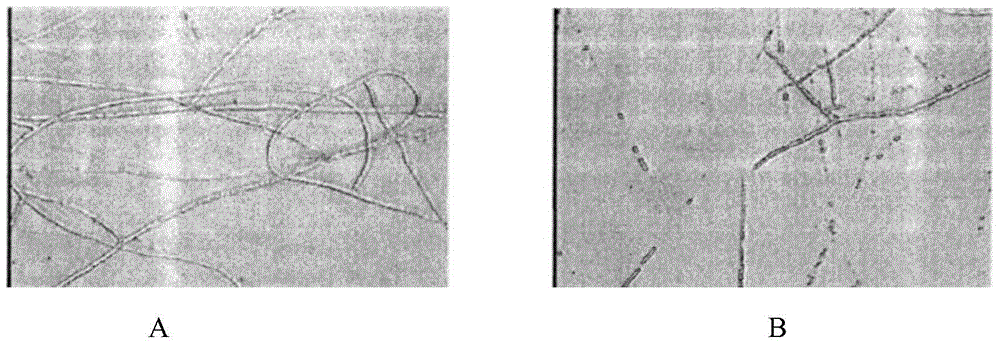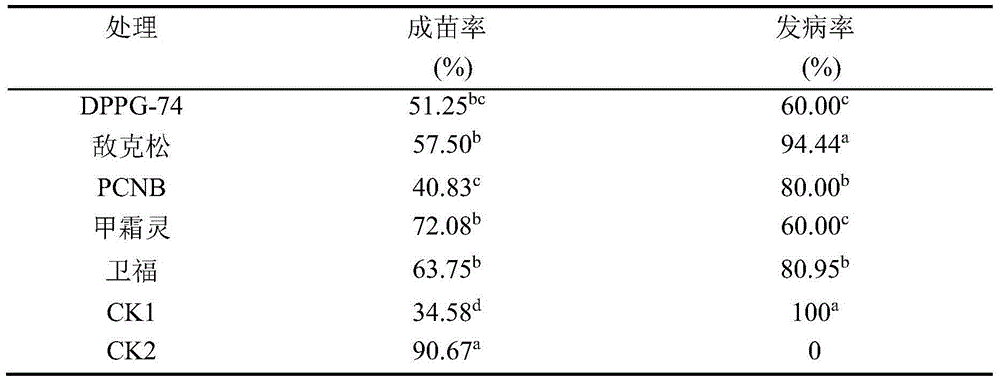Bacillus amyloliquefaciens DPPG-74 and its use in disease prevention and growth promotion
A technology of DPPG-74 and Bacillus amyloliquefaciens, which is applied in the field of agricultural biology, can solve problems such as unstable performance, and achieve broad-spectrum antibacterial activity, strong resistance to stress, and stable application effects
- Summary
- Abstract
- Description
- Claims
- Application Information
AI Technical Summary
Problems solved by technology
Method used
Image
Examples
Embodiment 1
[0022] Example 1 Screening and identification of disease-preventing and growth-promoting bacteria DPPG-74
[0023] The screening steps are as follows:
[0024] Step 1: Sampling
[0025] Collected from the soil with severe root rot in the early spring seedling stage of processing tomato.
[0026] Step Two: Enrichment
[0027] Weigh 10g of the soil samples collected from the processing tomato production area, add 100mL of sterilized water, then add appropriate amount of glass beads and shake vigorously for 30min (to fully disperse the soil particles), let it stand for 10min, take 1mL of the supernatant and add In a Erlenmeyer flask filled with 99mL of sterilized water, carry out gradient dilution. Isolate bacteria to take 10 -4 、10 -6 concentration. Add 200 μl of each of the above dilutions to PDA, NA and Gao’s No. 1 medium plates, spread evenly with a spreader, cool and place them upside down in a 28°C incubator for cultivation, and repeat three times. After 3-7 days, si...
Embodiment 2
[0044] Example 2 Bacillus amyloliquefaciens DPPG-74 has disease-preventing and growth-promoting characteristics of processed tomato
[0045] The fermented stock solution of the DPPG-74 strain (10 11 cfu / ml) soak processed tomato seeds, soak for 12h and then dry for later use. Then the treated tomato seeds were evenly sown into the nutrient bowl, and three controls were set up: CK 1 (Soaking seeds in sterilized culture solution, diseased soil), CK 2 (soak seeds in sterilized culture solution, the soil is sterilized soil), CK 3 (Chemical pesticides PCNB, metalaxyl, Weifu seed coating agent and Dikexon soaked processed tomato seeds, diseased soil). 20 seeds per pot, three repetitions per treatment, regular watering: 30 days after seed emergence, the seedling rate, growth and disease incidence were investigated. Perform statistical analysis on the results.
[0046] Table 3 Determination of the control effect of antagonistic bacteria on tomato Pythium root rot
[0047]
[...
Embodiment 3
[0050] Embodiment 3 Bacillus amyloliquefaciens DPPG-74 is to Pythium mycelia morphology influence
[0051] Add 20mL of PD culture solution to a sterile petri dish with a diameter of 90mm, insert a piece of bacteria sheet with a diameter of 8mm, and place it at a constant temperature at 6°C for 2 days. After 24 hours of treatment with the bacteria, the mycelium was picked to observe the shape of the mycelium under a microscope, and compared with the shape of the mycelium that had not been treated with the disease-preventing and growth-promoting bacteria. Each treatment was repeated four times, and water control was set.
[0052] Preliminary study on the antibacterial mechanism of Pythium melon and fruit mycelium will be treated with the biocontrol bacteria DPPG-74. Such as figure 1 As shown, the influence of biocontrol bacteria on the mycelium of Pythium melon and fruit can be observed under the microscope, and the mycelium morphology of Pythium melon and fruit after 48 hours...
PUM
 Login to View More
Login to View More Abstract
Description
Claims
Application Information
 Login to View More
Login to View More - R&D
- Intellectual Property
- Life Sciences
- Materials
- Tech Scout
- Unparalleled Data Quality
- Higher Quality Content
- 60% Fewer Hallucinations
Browse by: Latest US Patents, China's latest patents, Technical Efficacy Thesaurus, Application Domain, Technology Topic, Popular Technical Reports.
© 2025 PatSnap. All rights reserved.Legal|Privacy policy|Modern Slavery Act Transparency Statement|Sitemap|About US| Contact US: help@patsnap.com



